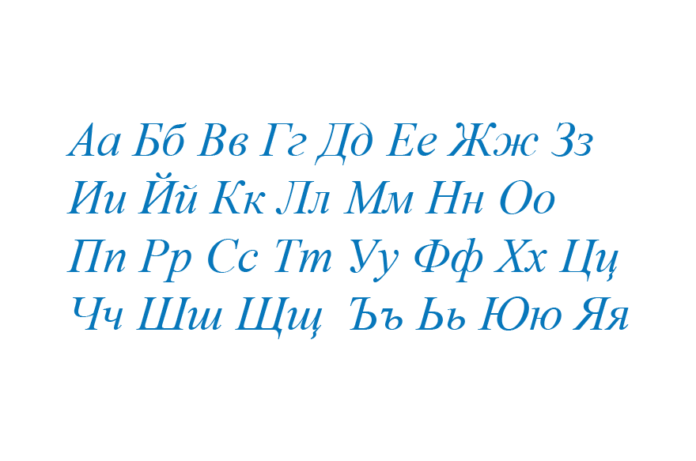The Bulgarian alphabet is an alphabet used to write the Bulgarian language. It is based on the Cyrillic alphabet, developed in the 9th century by missionaries Saints Cyril and Methodius and modified better to suit the phonetic characteristics of the Bulgarian language.
Today’s Bulgarian alphabet consists of 30 letters, and it is written from left to right. It includes the following letters:
А Б В Г Д Е Ж З И Й К Л М Н О П Р С Т У Ф Х Ц Ч Ш Щ Ъ Ь Ю Я
Here is a pronunciation guide for the Bulgarian alphabet:
- А – “a” as in “father”
- Б – “b” as in “bat”
- В – “v” as in “van”
- Г – “g” as in “go”
- Д – “d” as in “dog”
- Е – “e” as in “red”
- Ж – “zh” as in “measure”
- З – “z” as in “zoo
- И – “i” as in “bit”
- Й – “y” as in “yes”
- К – “k” as in “kit”
- Л – “l” as in “light”
- М – “m” as in “man”
- Н – “n” as in “night”
- О – “o” as in “note”
- П – “p” as in “pat”
- Р – “r” as in “rat”
- С – “s” as in “sun”
- Т – “t” as in “time”
- У – “u” as in “put”
- Ф – “f” as in “fun”
- Х – “h” as in “hat”
- Ц – “ts” as in “bits”
- Ч – “ch” as in “chat”
- Ш – “sh” as in “shoe”
- Щ – “sht” as in “shut”
- Ъ – “a” as in “father” (used only to separate certain prefixes and suffixes from the root of a word)
- Ь – “y” as in “yes” (used only to indicate palatalization of the preceding consonant)
- Ю – “yu” as in “yule”
- Я – “ya” as in “yacht”
Origins and History of the Bulgarian Alphabet
In 886, Bulgaria adopted the Glagolitic alphabet, created by St. Cyril and St. Methodius. According to the work “About the Letters” by the Bulgarian writer Chernorizets Hrabar, the Glagolitic script was created in 6363, corresponding to 855/863 in the current calendar. Over time, the Glagolitic alphabet was replaced by the Cyrillic alphabet, which was developed in the Preslav Book School at the beginning of the 10th century. The Cyrillic alphabet is based on the Greek alphabet but includes additional letters derived from the Glagolitic alphabet to represent sounds that did not have equivalents in Greek. These letters are б, ж, ч, ш, шт, ѧ, ѫ, ъ, ь, ѣ, ю, ѩ, ѭ. The oldest known Bulgarian written documents date from the end of the 10th and the beginning of the 11th century.
Several pieces of evidence suggest that the Glagolitic alphabet is older than the Cyrillic alphabet:
- The oldest known Bulgarian written documents, such as the Gospel of Zograf, the Gospel of Mary, and the Sinai Prayer Book, are written in Glagolitic.
- The language used in Glagolitic documents contains older linguistic features.
- Some book manuscripts written in Cyrillic on parchment show evidence of having originally been written in Glagolitic, but the Glagolitic writing was scraped off, and only traces remain. These are known as palimpsests, such as the Boyan Gospel from the 13th century.
The Earliest Known Old Bulgarian Text
The earliest known Old Bulgarian text written in the Cyrillic alphabet is an inscription by Chrgubilya Mostich, a high-ranking official under Tsars Simeon the Great and Peter. The next earliest known text is an inscription on a stone tablet from 993, placed by King Samuel in memory of his family. The traditional version of the Cyrillic alphabet, which included the letters Ћ and Џ, was widely used in Bulgaria until the early 19th century. These letters were added in the 14th or 15th centuries and were occasionally used in texts.
A significant event in the history of the Bulgarian alphabet was the transition from the traditional Cyrillic alphabet to a modified version of the Russian civil alphabet in the 1830s. This change was influenced by the widespread use of Russian literature (including the availability of printing presses and book publishing) and the influence of Pan-Slavic ideas at the time. The Bulgarian civil alphabet retained the letters Ѫ (a large handkerchief) and Ѭ (an ioted large handkerchief) from the old Cyrillic alphabet. Still, it replaced Ы and Е with letters not used in the Bulgarian alphabet. The letter Я was also adopted from the Russian civil alphabet, replacing the Old Bulgarian letter Ꙗ. The modern Bulgarian Cyrillic alphabet was finalized in 1945 when the letters Ѣ (double E) and Ѫ (big handkerchief) were removed during a spelling reform.
Modern Times
On May 24th each year, Bulgaria comes alive with an effusion of color and festive events to celebrate the Day of the Slavonic Alphabet, Bulgarian Enlightenment, and Culture. During this annual event, Bulgarians pay homage to the Slavic lineage and Bulgaria’s abundant intellectual and cultural customs. This day is not just an event but a manifestation of intense pride and fervor. It is a time for Bulgarians, both within the country and overseas, to honor their historical roots and acknowledge the valuable legacy handed down by their forebears that continues to shape their present and future.
Curious Fact
Google Fonts currently has one Glagolithic font is – Noto Sans Glagolithic.



